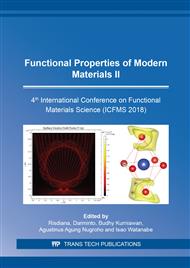p.35
p.41
p.48
p.54
p.60
p.66
p.72
p.77
p.83
Preparation and Characterization of Electrospun Composite Fiber of Polymer-TiO2
Abstract:
Nanocrystal TiO2 has been synthesized from TiCl3 as a precursor using the co-precipitation method. Synthesis parameters are chosen to produce the anatase phase of TiO2 nanomaterials. Polymer-TiO2 composite was made from a mixture of TiO2 nanomaterials and poly(vinyl alcohol) (PVA) and ethyl cellulose polymer materials. PVA solvents were used by water (H2O) while for ethyl cellulose used terpineol solvents. Composite fiber was made using electrospinning method with sedimentation parameters: between the syringe and Al foil collector applied the voltage at 10 kV, between the needle tip and the collector, the distance was 10 cm, the syringe pump was set at a constant flow rate of 1 ml/h, the collector rotation speed was 100 rpm , and humidity inside electrospinning machine was 40%. Samples were characterized using scanning electron microscopy (SEM) and x-ray diffraction (XRD). XRD results showed TiO2 crystal diffraction peaks when the composition of TiO2 was quite large, whereas for only a small TiO2 composition, the diffraction peaks did not appear and were only dominated by amorphous PVA. Deposition results showed that composite fibers have been formed for PVA polymers whereas fiber ethyl cellulose was not formed.
Info:
Periodical:
Pages:
60-65
Citation:
Online since:
August 2019
Authors:
Keywords:
Price:
Сopyright:
© 2019 Trans Tech Publications Ltd. All Rights Reserved
Share:
Citation:


